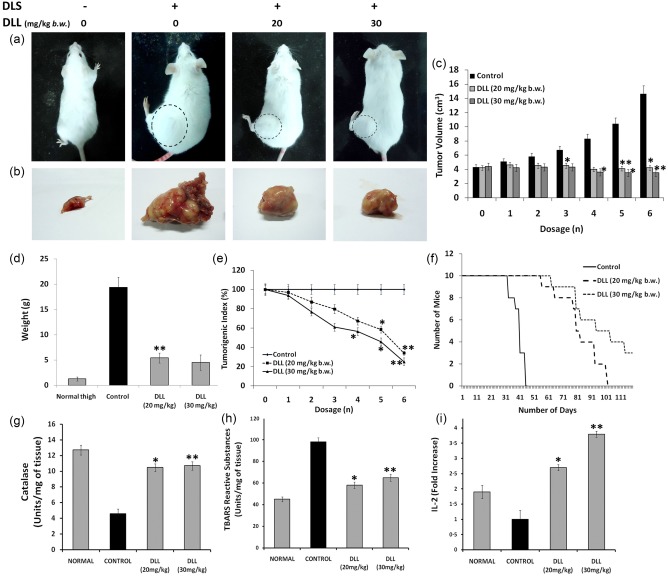Figure 4.

Dolichos lablab lectin (DLL) mitigates the proliferation of murine Dalton's lymphoma solid tumour in‐vivo with up‐regulation of IL‐2 levels. Solid tumour was induced by injecting Dalton's lymphoma cells (1 × 106 cells/mouse) in hindlimbs of Swiss albino mice. After the palpable development of tumour, six doses of DLL (20 and 30 mg/kg body weight b.w.) were administered intraperitoneally (i.p.) to tumour‐bearing mice on every alternative day. (a) Tumour morphology of the DLS‐induced mice with and without DLL treatment. The circular dotted lines represent the extent of tumour growth. (b) Gross anatomical appearance of the excised DLS tumours. Note the extensive vascularization surrounding the tumour tissue of the untreated control. (c) The effect of DLL on DLS tumour progression at different time‐points. (d) Weight of the excised normal thigh, control and DLL‐treated tumours (g). (e) Tumorigenic index elucidating the dose‐dependent decrease of tumour progression post‐DLL regimen. (f) Kaplan–Meier survival curve of the animals treated with DLL. Effect of DLL in the endogenous hepatic anti‐oxidant system (d) pronounced catalase enzymes levels in DLL‐treated mice. Note control with severely declined enzyme content. (e) Decreased lipid peroxidation in DLL‐treated mice, as assessed by the thiobarbituric reactive substances (TBARS) method. (f) Fold difference in the serum interleukin (IL)‐2 levels of DLL‐treated animals compared to control. The control animal shows declined levels of IL‐2, whereas DLL at 20 and 30 mg/kg b.w. via i.p. administration shows pronounced IL‐2 levels. Results are the means of three determinations, each conducted in triplicate. Statistically significant values are *P < 0·05; ** P < 0·01. [Colour figure can be viewed at wileyonlinelibrary.com].
